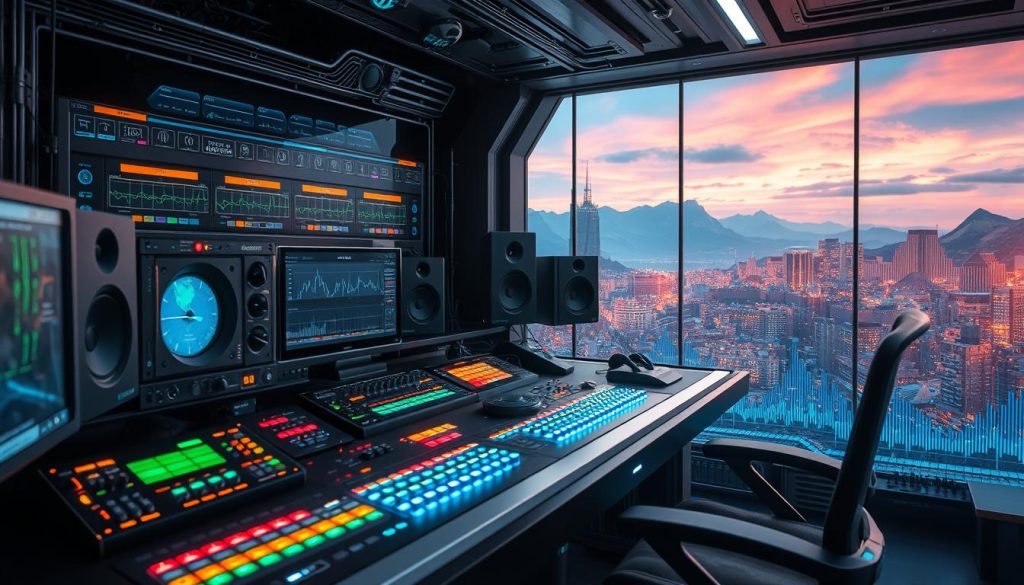I’m excited to share the latest in audio technology. The field is changing fast, thanks to new tech in smart speakers, voice helpers, spatial audio, and AI sound. These changes are mixing the real and digital worlds, changing how we hear and interact with sound.
Immersive sound and spatial audio are big news, changing how we enjoy and talk with others. New companies are making 3D audio that takes us into amazing sound worlds. This makes us feel like we’re right there, in the moment.
There’s also big progress in making audio better and cutting out background noise. Smart tech now can remove unwanted sounds and make audio clearer. This means we can hear every word and tune clearly.
Now, audio tech is getting more personal. It’s adjusting to what each person likes and needs to hear. This brings us into a new world of sound made just for us.
Audio tech is also key in virtual and augmented reality. It mixes the real and digital worlds in new ways. As these technologies grow, audio will make us feel more connected and real.
Cloud-based tools for making and working on audio are becoming more common. They let remote teams work together easily. This makes making audio content faster and more efficient.
AI and machine learning are also changing audio engineering. These smart systems are improving sound quality, doing boring tasks automatically, and opening up new creative ways for audio experts and fans.
Exploring these audio tech trends is exciting. They’re set to change how we enjoy, communicate, and see the world. The future of sound looks bright, and I’m eager to see what new tech comes next.
Immersive Sound and Spatial Audio
The rise of immersive sound and spatial audio is changing how we hear audio. It lets sound engineers make sounds seem like they come from all around us. This makes virtual places feel more real and fun for listeners.
Startups are using new sound tech and learning from machines to change how we use audio in virtual and augmented reality. This is making our audio experiences better.
Startups Revolutionizing 3D Audio Experiences
MezzoForte and Treble are leading this audio change. They’re making cloud-based platforms and tech that let us dive into spatial audio, 3D audio, and surround sound. These solutions are changing how we hear immersive audio and virtual reality audio in places like museums, concerts, and virtual worlds.
These startups use 3D sound experiences to make sounds seem to come from different places. This makes the audio more real and fun. It also opens new doors for augmented reality audio and immersive audio in many fields.
As we want more immersive audio, these startups are leading the way. They’re making a future where sound and tech blend to give us amazing audio experiences.
Audio Enhancement and Noise Cancellation
In today’s world, old recordings often sound bad. But new tech is helping fix this. It makes old sounds clear and new again.
Companies like Cleanvoice and Supertone lead this change. They use AI to make old, low-quality recordings sound better. This helps musicians, filmmakers, and editors make their work sound great.
These techs use audio enhancement and noise reduction to make sounds clear. They use advanced methods like spectral editing and AI algorithms for this.
Now, musicians can make their old songs sound fresh. Filmmakers can make their movies sound better. And audio editors can make their work sound amazing.
As we want better sound quality, these techs are key. They will change how we make and listen to audio in the future.
Personalized Sound Experiences
Today, we’re seeing a big change in how we hear sound. Old audio systems didn’t really think about what each person likes. But new startups are changing that, making sound more personal.
These startups use new tech to let people make their own sound settings. With apps and algorithms, you can adjust things like bass and treble. This makes the sound better for you.
Tailoring Audio to Individual Preferences
It’s not just about turning up the volume or changing the sound settings. New tech uses learning and AI to get to know what you like. It changes the sound to fit your hearing and where you are, making it better for you.
This isn’t just for fun. It’s also helping people with hearing problems or sensitivities. And in work settings, it makes teams work better together by letting everyone set up their own sound.
The need for custom sound is growing fast. This is changing the audio industry big time. Soon, we’ll all be able to make sound our own way, making listening better for everyone.
audio technology trends in Virtual and Augmented Reality

The world of VR and AR is changing how we make audio. It’s making sound experiences more immersive and interactive. In VR, we can create 3D sound fields that feel like they’re all around us. This makes us feel like we’re really there.
AR lets us mix digital sounds with what we see in the real world. This adds depth and makes things more interactive. It’s changing how movies and shows are made, making them more engaging.
Now, making movies and content with VR audio and AR audio is key. It lets creators make interactive audio experiences that pull us in. This makes the line between real and digital worlds fade.
As more people want audio-driven visual effects, engineers are finding new ways to improve our experience. They’re using sound that moves with us and changes with the scene. The future of VR audio and AR audio is wide open.
| VR Audio | AR Audio |
|---|---|
| Spatial audio techniques for 3D sound fields | Integration of digital audio with real-world visuals |
| Enhanced sense of presence and immersion | Added depth and interactivity to the viewing experience |
| Innovative audio-driven visual effects | Directional sound cues and dynamic soundscapes |
The lines between the real and digital worlds are getting closer. This is changing how we see and interact with media. The future of audio looks set to be more immersive and engaging, in movies, games, and more.
Cloud-Based Audio Production and Collaboration
The audio industry has changed a lot in recent years. This change is thanks to cloud-based audio production and working together from afar. Now, audio experts use cloud audio production tools and web-based audio platforms. These tools make working together and getting adaptive streaming audio easy.
Remote Audio Workflows Reshaping the Industry
The COVID-19 pandemic made remote audio workflows more popular. Audio engineers and musicians had to work together from different places. Cloud-based audio platforms helped them work together in real-time, no matter where they were.
These platforms offer many features to make creating music easier. You can record music remotely, use virtual mixing consoles, and store your projects in the cloud. Thanks to adaptive streaming audio, everyone can hear the music clearly, no matter their device or internet speed.
As the audio industry keeps changing, remote audio workflows are changing how audio experts work. They now have more flexible and team-focused work settings. These settings don’t care about where you are in the world.
AI and Machine Learning in Audio Engineering

The world of audio engineering is changing fast, thanks to AI and ML. These new technologies are making many tasks easier and faster for sound professionals. They automate tasks that used to take a lot of time and effort.
AI-powered software can now quickly sort through music tracks. This helps audio engineers find the right samples and sounds fast. Machine learning algorithms are also making mixing and mastering easier. Engineers can now get professional-quality results without spending so much time.
These technologies are doing more than just help with sound production. They’re also helping sound designers create new sound effects and automate audio processing. As they get better, audio engineers will have tools that open up new creative possibilities and bring new ideas to the industry.
| Technology | Application | Benefits |
|---|---|---|
| AI in Audio | Music analysis and categorization | Streamlined sound selection and project management |
| Machine Learning in Audio | Automated mixing and mastering | Improved workflow efficiency and consistent audio quality |
| AI-Powered Sound Design | Generative sound effects and audio processing | Unlocking new creative possibilities and enhancing workflows |
The audio engineering industry is always changing, and AI and ML will play a big part in its future. These tools are automating boring tasks and letting engineers be more creative. They’re going to change how we make and experience audio content.
The Future of Audio in Film and Television
The evolution of audio technology has changed the film industry a lot. It has changed how stories are told and how we experience them. New tech in film audio, like high-resolution recording and immersive 3D audio, makes sounds more real and engaging.
Sound design and editing are getting better too. They use AI and advanced tools to make creating sounds easier and more complex. This means we get to enjoy more amazing audio in movies and TV shows.
Audio and visual technologies are working together more smoothly now. This makes movies and TV shows more engaging and immersive. Filmmakers and producers have more tools to make stories come alive with sound.
Innovations Enhancing Cinematic Experiences
New tech in film audio is taking movies to the next level. Techniques like binaural and 3D audio make us feel like we’re right in the action. Advanced software, helped by AI, makes creating sounds easier and more detailed.
| Feature | Impact on Cinematic Experiences |
|---|---|
| High-Resolution Audio Capture | Enhances sound quality and fidelity, providing a more detailed and lifelike audio experience. |
| Immersive 3D Audio | Immerses audiences in a multi-dimensional soundscape, creating a more immersive and engaging cinematic experience. |
| Audio-Visual Integration | Seamless synchronization of audio and visual elements, resulting in a more cohesive and captivating storytelling experience. |
As film and TV keep using these new audio technologies, we’ll get to enjoy more immersive and cinematic experiences. These experiences will make us feel like we’re part of the story, taking storytelling to new heights.
The Impact of Streaming Platforms on Audio Quality
Streaming platforms have changed the entertainment world a lot. They’ve made big changes in audio technology. Now, they’re always trying to give better sound to their viewers.
These services use new audio codecs and high-resolution formats for richer sounds. They use the latest tech to give viewers a deeper, more movie-like sound. Also, they adjust the sound quality based on your internet speed for a smooth watch.
Improving audio quality is key for streaming services. It shows how important great sound is in today’s streaming world. This change is changing how movies and TV shows are made and watched. It’s also changing the future of entertainment.

